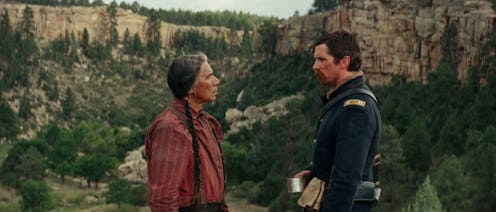Entertainment
Christian Bale's New Movie Is A Western, But Its Depiction Of Racism Feels Eerily Current

It's the end of the year, which means movie studios are frantically releasing loads of prestige pictures in the hopes of drawing the attention of the Oscars. One of these films is Hostiles, which has a decent amount of pedigree thanks to its big stars, Oscar-winner Christian Bale and Oscar-nominee Rosamund Pike, as well as its period setting. The epic western takes place in the late 1800s, and tells the story of an army captain who takes on a dangerous mission to escort a dying Cheyenne war chief home to his tribe. The setting and subject matter certainly give the film a realistic impression, but is Hostiles a true story?
The movie is fictional, and is not based on a specific true story. The idea for the plot actually came from an old manuscript written by the late screenwriter Donald E. Stewart, whose other credits include Oscar-winner Missing and the '90s trilogy of Jack Ryan films: The Hunt for Red October, Patriot Games, and Clear and Present Danger. Stewart passed away in 1999, long before anything came of his script that would eventually become Hostiles, but the story didn't die with him.
Writer/director Scott Cooper used Stewart's script as a base for his own story, and wrote and directed Hostiles himself out of his desire to create a western in the vein of classic western directors like John Ford while also modernizing the genre to reflect the current racial divide in America, as the film takes place during the Indian Wars at the height of racial tension between Native Americans and the white settlers increasingly encroaching on their territory.
"[Stewart's] manuscript was written sometime in the 1980s or ’90s," Cooper told the Los Angeles Daily News' Bob Strauss. "I wanted it to feel very relevant and current, socially and politically, because when I was working on the screenplay the racial and cultural divide in America was wide. I didn’t realize it was as wide as it was until last November, and it’s growing wider by the day. The film that I want to sell is a film about inclusion and healing and reconciliation. I thought it was important to make it feel that what happened in 1892 is continuing to happen today."
Adding to the authenticity of the film was the shoot itself, which was conducted across a great expanse of the the western United States, mimicking the long journey the characters take in the film from Arizona to Montana. "I never shot in the same location twice except for one cabin. I was literally journeying from New Mexico far north, up into the Rocky Mountains," Cooper told the Los Angeles Daily News. "I was able to see a part of America that I otherwise never would have seen, and work with those locations that help tell a story, that help inform character and help form the psychology of these men and women as they traverse the thousand-mile journey."
Period-specific authenticity is further represented in the film's casting, as Yellow Hawk, the movie's Cheyenne war chief, is played by actor Wes Studi, who is Cherokee. Although he is not a member of the same tribe as his character, Studi is a Native American — as are several other actors in the film — which bucks the long-running Hollywood tradition of neglecting Native American actors for Native American roles, and he even learned to speak Cheyenne for the film.
"It’s a difficult language," the actor told the Los Angeles Times' Josh Rottenberg. "I like to think I have a little edge on it because I’m willing to experiment with different sounds and my tongue is capable of speaking Cherokee, which has a lot of sounds that are made differently. But as far as understanding goes, that part is difficult. It’s phonetics. You’re just making the sounds."
The story of Hostiles may be fictional, but thanks to its on-location filming and authentic casting, the movie paints a somewhat realistic picture of life during the days of American Frontier.